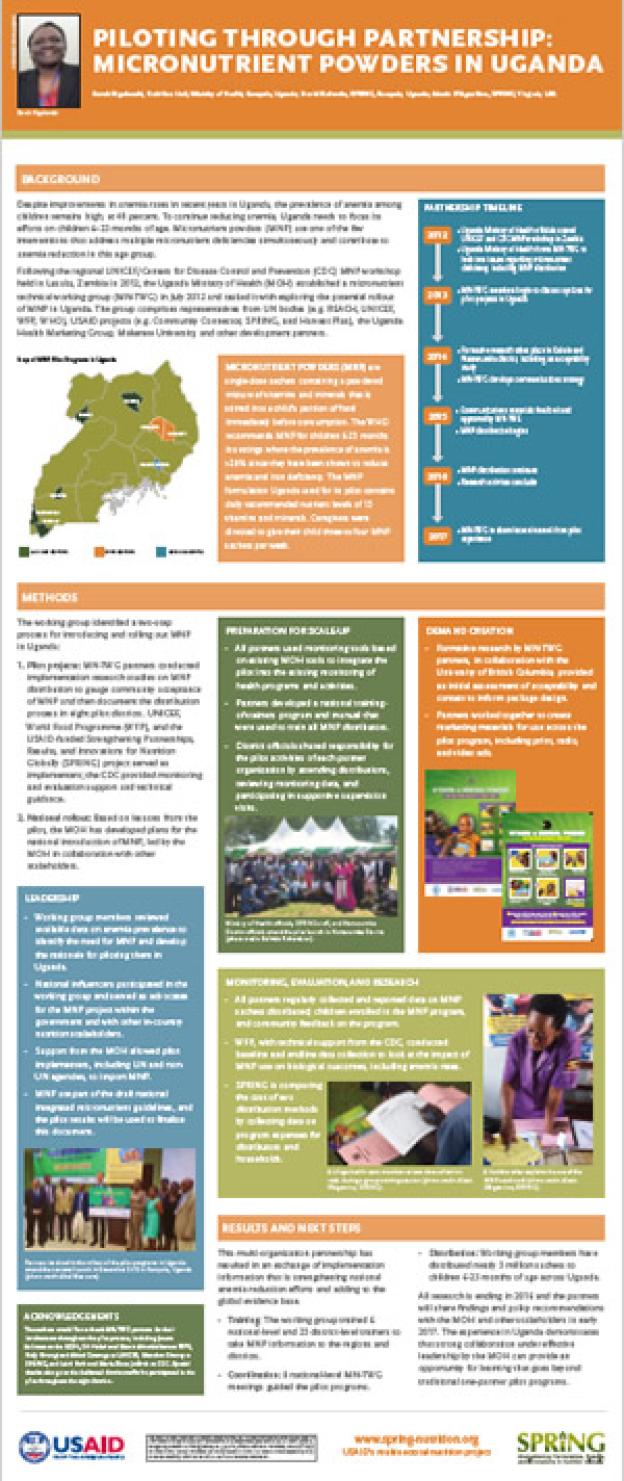Background
Despite improvements in anemia rates in recent years in Uganda, the prevalence of anemia among children remains high, at 49 percent. To continue reducing anemia, Uganda needs to focus its efforts on children 6–23 months of age. Micronutrient powders (MNP) are one of the few interventions that address multiple micronutrient deficiencies simultaneously and contribute to anemia reduction in this age group.
Following the regional UNICEF/Centers for Disease Control and Prevention (CDC) MNP workshop held in Lusaka, Zambia in 2012, the Uganda Ministry of Health (MOH) established a micronutrient technical working group (MN-TWG) in July 2012 and tasked it with exploring the potential rollout of MNP in Uganda. The group comprises representatives from UN bodies (e.g. REACH, UNICEF, WFP, WHO), USAID projects (e.g. Community Connector, SPRING, and Harvest Plus), the Uganda Health Marketing Group, Makerere University, and other development partners.
Mironutrient Powders (MNP) are single-dose sachets containing a mixture of vitamins and minerals that is stirred into a child’s portion of food immediately before consumption. The WHO recommendations MNP for children 6-23 months in settings where the prevalence of anemia is >20% since they have been shown to reduce anemia and iron deficiency. The MNP formulation Uganda is using for its pilot contains daily recommended nutrient levels of 15 vitamins and minerals. Caregivers were directed to give their child three to four MNP sachets per week.
- Uganda Ministry of Health officials attend UNICEF and CDC MNP workshop in Zambia
- Uganda Ministry of Health forms MN-TWG to look into issues regarding micronutrient deficiency, including MNP distribution
- MN-TWG members begin to discuss options for pilot projects in Uganda
- Formative research takes place in Kabale and Namutumba district, including an acceptability study
- MN-TWG develops communications strategy
- Communications materials finalized and approved by MN-TWG
- MNP distribution begins
- MNP distribution continues
- Research activites conclude
- MN-TWG to share lesson learned from pilot experience

Methods
The working group identified a two-step process for introducing and rolling out MNP in Uganda:
- Pilot projects: MN-TWG partners conducted implementation research studies on MNP distribution to gauge community acceptance of MNP and then document the distribution process in eight pilot districts. UNICEF, World Food Programme (WFP), and the USAID-funded Strengthening Partnerships, Results, and Innovations for Nutrition Globally (SPRING) project served as implementers; the CDC provided monitoring and evaluation support and technical guidance.
- National rollout: Based on lessons from the pilot, the MOH has developed plans for the national introduction of MNP, led by the MOH in collaboration with other stakeholders.

Leadership
- Working group members reviewed available data on anemia prevalence to identify the need for MNP and develop the rationale for piloting them in Uganda.
- National influencers participated in the working group and served as advocates for the MNP project within the government and with other in-country nutrition stakeholders.
- Support from the MOH allowed pilot implementers, including UN and non- UN agencies, to import MNP.
- MNP are part of the draft national integrated micronutrient guidelines, and the pilot results will be used to finalize this document.

Preparation for Scale-Up
- All partners used monitoring tools based on existing MOH tools to integrate the pilot into the existing monitoring of health programs and activities.
- Partners developed a national training of trainers program and manual that were used to train all MNP distributors.
- District officials shared responsibility for the pilot activities of each partner organization by attending distributions, reviewing monitoring data, and participating in supportive supervision visits.

Demand Creation
- Formative research by MN-TWG partners, in collaboration with the University of British Columbia, provided an initial assessment of acceptability and context to inform package design.
- Partners worked together to create marketing materials for use across the pilot program, including print, radio, and video ads.

Monitoring, Evaluation, and Research
- All partners regularly collected and reported data on MNP sachets distributed, children enrolled in the MNP program, and community feedback on the program.
- WFP, with technical support from the CDC, conducted baseline and endline data collection to look at the impact of MNP use on biological outcomes, including anemia rates.
- SPRING is comparing the cost of two distribution methods by collecting data on program expenses for distributors and households.

